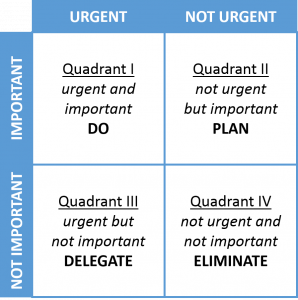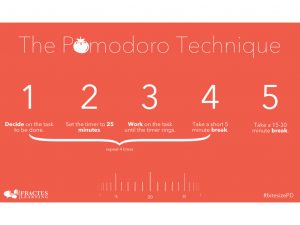Towers of paper. Desk full of random garbage. Post-it notes all around the place. Time for a proper task management system!
You can’t be constantly productive. And you should not want to be.
Some days are productive, some are more lazy. You are not a robot. People deal with emotions, hangovers, fatigue, etc. We need a day off sometimes.
You can, however, be more organized. Systems like ZTD or GTD can help with that. Pomodoro technique can increase your work-focus.
So let’s look at few options. What are we gonna cover in this piece?
Zen to Done
System which will guide you to actually complete tasks.
The most elementary type of Zen to Done really focuses on four things. First, collect your thoughts by keeping a notebook with you to write down thoughts and ideas as they come to you. Secondly, process those thoughts by making rapid decisions on each of the things you wrote down — what exactly do you want to do with them? Third, plan your day by focusing only on the most important things you have jotted down and allowing everything flow around it. Fourth, do some stuff — focus exclusively on one task at a time, then proceed to another when that one is completed. That’s it.
Acquiring the 10 Habits
Leo’s main pet peeve about Getting Things Done is the fact that it takes one to devote to a whole group of new customs all at one time.
Leo argues that it is a lot easier to learn one habit at a time, so he reduced Getting Things Done (and some other theories) into ten distinct customs that could be learned one at a time rather than all at once. Learning any one of those customs can be useful — learning all of them over time may be a significant boost.
Habit 1: Gather
Keep a notebook with you at all times and each time a thought occurs to you that you will have to recall afterwards, write it down immediately. That includes thoughts, tasks to be done, things that you would like to investigate later, little details you will need to remember, etc.
Habit 2: Process
When you get home, whip out that laptop and process all the things in it. Decide if it could be managed quickly (like using a fast action to finish a job or a fast web search to discover a fact), has to be filed, has to be given to somebody else, can be tossed (since it was futile), or has to be handled with a few concentrated attention. Get through everything on your laptop at once — and in all your other message places, too, like your email, your text messages, and your voicemail. You ought to be constructing a list of things to do from this.
Habit 3: Plan
daily, you must have one to three Important Tasks which you really should get done that day. Those tasks ought to be the first ones on your own to-do list for this day. Those are your stones — the centerpieces of the day. After that, you should fill your day with the sand — smaller jobs in your own to-do listing that fill in the area around the stones. By way of instance, my”stones” are usually straightforward Dollar articles or posts (or other similar content production ), while my”sand” is material like correspondence with readers. Have a list of”stones” for every day — one to three important jobs — and then a listing of “sand” to fill in the gaps.
Habit 4: Do
This is not as obvious as it may seem. Basically, the idea is to select a”stone” (one of your key activities for the day) then enter the zone by removing all the distractions around you — turn off your phone, your email program, your IM app, etc. Then just concentrate on nothing but the undertaking. If you get interrupted, simply write down the interruption in your notebook for another processing (after you are done with the job ) and do not get off task. If your stone is of a reasonable size, you can knock it off in a couple of hours, then you may take care of the sand — the missed messages, tasks, and other things you will need to address through a processing session. This really works — I do it all of the time when I am writing a post. I’ll write a comprehensive post in 1 shot, then stop and do other smaller jobs as a”break” before I take on another article.
Habit 5: Simple, Trusted System
Do not make your system for keeping track of things too complex. Leo proposes using five”to-do” lists — work, private, errands, calls you will need to make, and a”waiting for” list comprised of stuff you are waiting on until you can make progress. Each one is a mixture of big things and small things — on each one, I indicate”big” jobs with a celebrity so if I have some free time, I fly through the list and only eliminate unstarred stuff.
Habit 6: Organize
Clutter is your enemy. Everything should have a place, and getting in the routine of making sure your stuff finds its correct place is invaluable. That is easily the habit that I have the hardest time with, as it’s easy for me to have my own office area descend into chaos over the course of a week or so as I pull out reference materials and don’t place them back, leave stuff out for me to view afterwards, and collect stuff that really has to be pitched or filed.
Habit 7: Review
Each week, set aside some time to review where you are at and where you want to go. Leo advises a five step process. First, review your most important long term goal and your most important short term goal. Second, review your notes — go through your notebook and make sure you haven’t missed anything. Third, review your calendar — make sure you did not forget about a follow-up for something which happened during the week and also make sure you’re prepared for the coming week. Review your lists to make sure that you haven’t missed something vital or if there’s something that can easily be accomplished right now. Finally, determine what your short term goal for the coming week is and determine the big tasks you want to achieve every day.
Habit 8: Simplify
Spend some time arming the things you will need to do. Go through your”to-do” lists and be sure they are stuff you really have to be spending your time on. Focus entirely on your own rocks and allow the sand stream away — it is not really as significant, anyway.
Habit 9: Establish Routines
Settle into a daily regimen that incorporates as a number of these customs as possible. My daily routine usually is made up of correspondence and processing session in the morning, then a collection of”stones” (usually articles ), followed by a little”sand” (mails, eating, message follow-ups, etc.), and switching back and forth until the day is completed. This works really well for me.
Habit 10: Discover Your Passion!
Leo makes the astute point here that if you are not passionate about what you are doing, it is going to be very tough to adopt habits that let you succeed at it. If you love what you are doing, the diligence needed to make things work will come much more naturally.
The Eisenhower Matrix
What is the Eisenhower Matrix?
The Eisenhower Matrix, also referred to as Urgent-Important Matrix, helps you decide on and prioritize tasks by urgency and importance, sorting out less urgent and important tasks which you should either delegate or not do at all.
What’s with the name?
Dwight D. Eisenhower (the 34th President of the United States) needed to make tough decisions continuously about which of the many tasks he must concentrate on every day. This eventually led him to formulate the world-famous Eisenhower principle, which now helps us prioritize by urgency and significance.
How to implement the Eisenhower Matrix?
Prioritizing tasks by urgency and significance results in 4 quadrants with different work plans:

The “Do” quadrant
We call the first quadrant Do because its activities are important to your life and career and have to get done today or tomorrow at the latest. You could use a timer that will assist you concentrate while attempting to get as much of these done as possible.
An example of the sort of task might be to review a significant document for your own manager.
The “Plan” quadrant
The next quadrant we call Plan. Its activities are important but less urgent. You should record tasks you will need to put in your calendar .
An example of that might be a long-planned restart of your fitness center activity.
Professional time supervisors leave fewer things unplanned and for that reason try to manage the majority of their work in the next quadrant, reducing stress by terminating pressing and significant to-dos to some reasonable date in the future whenever a new job comes in.
The “Delegate” quadrant
The third quadrant is for all those tasks you could assign since they are not as important to you than others but still fairly urgent. You should keep an eye on delegated tasks by email, phone or inside a meeting to check back on their progress afterwards.
A good example of a delegated task may be someone calling you to request an urgent favor or ask that you step right into a meeting. You can delegate this responsibility by suggesting a better person for the job or by giving the caller the essential information to have him deal with the matter himself.
The “Eliminate” quadrant
The fourth and final quadrant is called Do not Dosince it’s there to help you sort things out you shouldn’t being doing in any way.
Discover and prevent bad habits, such as surfing the net without a reason or gaming too long, these give you an excuse for not having the ability to manage significant jobs in the 1st and 2nd quadrant.
The Pomodoro Technique
The thing about the pomodoro timer is that it is a system of effective work practice. You can dive into several hout long sessions of continuous works and browse facebook every 3 minute intervals without accountability and get distracted all time, as a result outputting low productive sessions. The pomodoro timer makes it so you have a defined work and break schedule and maximizes your productivity.
The Pomodoro Method
The Pomodoro Technique will help you power through distractions, hyper-focus, and get things done in brief bursts, even while taking regular breaks to develop air and unwind. On top of that, it is simple. In case you’ve got a busy job at which you are expected to make, it is a fantastic way to make it through your own tasks. Let us break it down and determine how you can apply it to your job.
What Is the Pomodoro Technique?
The Pomodoro Technique was devised in the early 90s by programmer, entrepeneur, and writer Francesco Cirillo. Cirillo called the machine”Pomodoro” following the tomato-shaped timer that he was able to monitor his job for a college student. The methodology is straightforward: When confronted with any huge undertaking or sequence of jobs, break down the work into brief, timed periods (known as”Pomodoros”) which are spaced out by brief breaks. This trains your mind to concentrate for brief periods and can help you keep on top of deadlines or constantly-refilling inboxes. With time it may even help improve your attention span and concentration.
Pomodoro is a system that is cyclical. You operate in short sprints, making sure you are always productive. In addition you get to take normal breaks that reinforce your motivation and help you to stay creative.
How the Pomodoro Technique Works
The Pomodoro Technique is most likely among the easiest productivity approaches to execute. All you will need is a timer. Beyond this, there aren’t any special programs, books, or resources needed. Cirillo’s publication, The Pomodoro Technique, is a beneficial read, however Cirillo himself does not conceal the crux of the method supporting a buy. Here is the Way to get started using Pomodoro, in five steps:
- Choose a task to be accomplished.
- Set the Pomodoro to 25 minutes (the Pomodoro is the timer)
- Work on the task until the Pomodoro rings, then put a check on your sheet of paper
- Take a short break (5 minutes is OK)
- Every 4 Pomodoros take a longer break
That “longer break” is generally on the order of 15-30 minutes, whatever it takes to make you feel recharged and ready to begin another 25-minute workout. Repeat this procedure several times over the course of a workday, and you really get a lot accomplished–and then required lots of breaks to grab a cup of java or refill your water bottle from the procedure.

It’s important to note that a pomodoro is an indivisible unit of work—that means if you’re distracted part-way by a coworker, meeting, or emergency, you either have to end the pomodoro there (saving your work and starting a new one later), or you have to postpone the distraction until the pomodoro is complete. If you can do the latter, Cirillo suggests the “inform, negotiate, and call back” strategy:
- Inform the other (distracting) party that you’re working on something right now.
- Negotiate a time when you can get back to them about the distracting issue in a timely manner.
- Schedule that follow-up immediately.
- Call back the other party when your pomodoro is complete and you’re ready to tackle their issue.
Of course, not every distraction is that simple, and some things demand immediate attention—but not every distraction does. Sometimes it’s perfectly fine to tell your coworker “I’m in the middle of something right now, but can I get back to you in….ten minutes?” Doing so doesn’t just keep you in the groove, it also gives you control over your workday.
How to Get Started with the Pomodoro Technique
Since a timer is the only essential Pomodoro tool, you can get started with any phone with a timer app, a countdown clock, or even a plain old egg timer. Cirillo himself prefers a manual timer, and says winding one up “confirms your determination to work.”
Top Gear Top Tip for Boosting Your Productivity
First things first
- Eat healthy
- Exercise
- Sleep enough
- Have your personal affairs in order
Now, what will directly help you with your productivity
- Do not try to multitask
- Start planning your days and weeks
- Make to-do lists and set deadlines
- Track your time
- Depending on your work, implement some (more or less complex) productivity system
Sources
- https://commons.wikimedia.org/wiki/File:7_habits_decision-making_matrix.png
- https://www.eisenhower.me/eisenhower-matrix/
- https://lifehacker.com/productivity-101-a-primer-to-the-pomodoro-technique-1598992730
- https://www.quora.com/Which-productive-methods-are-there-other-than-Pomodoro-technique
- https://www.flickr.com/photos/bionicteaching/45191993455
 Knowledge Base
Knowledge Base



